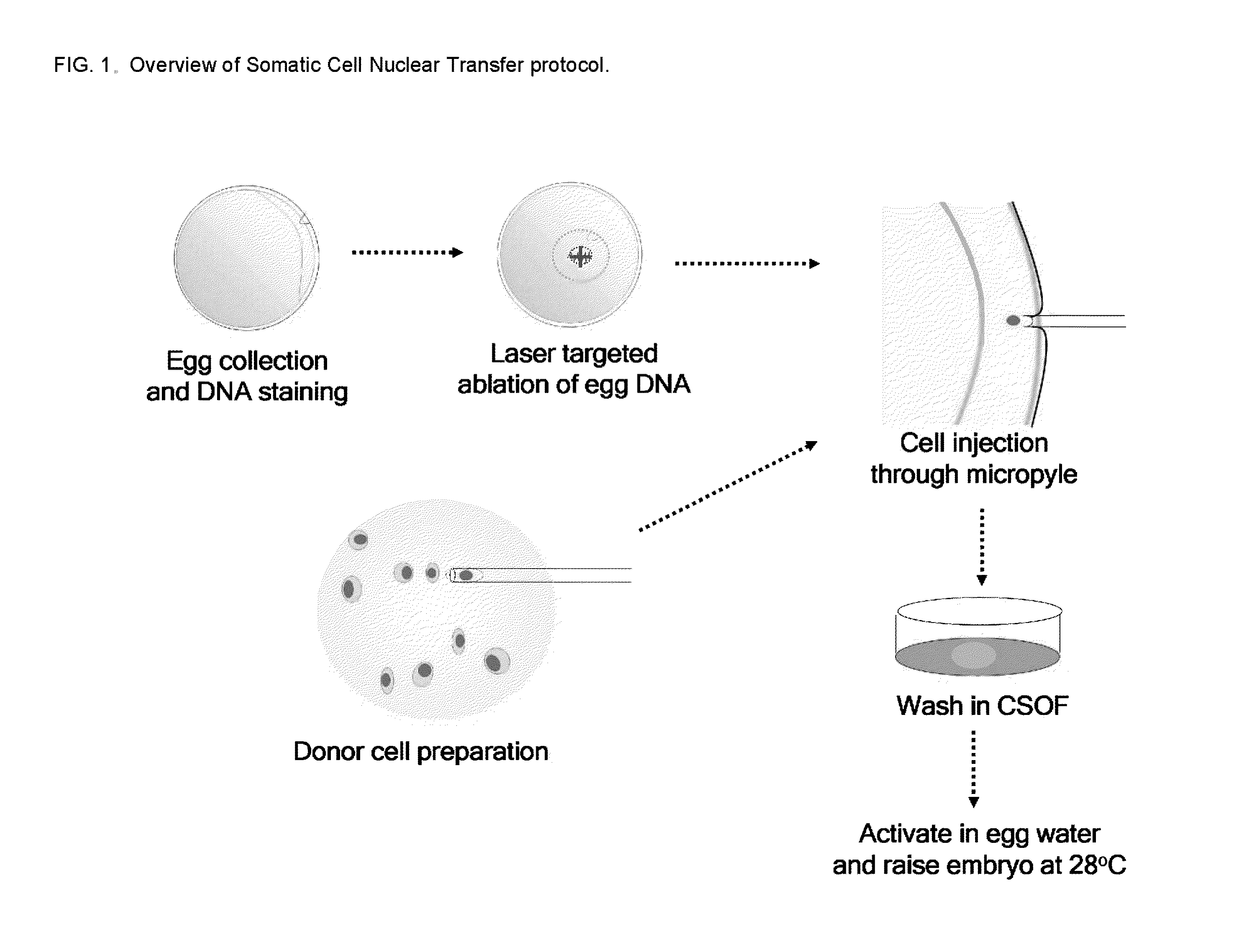Efficient Somatic Cell Nuclear Transfer In Fish
a somatic cell and nuclear transfer technology, applied in the field of therapeutic cloning and somatic cell nuclear transfer, can solve the problems of high labor and time-consuming ‘forward genetic’ approaches, no reports on the generation of germline-competent founder animals using the aforementioned, and conventional scnt methods are technically demanding, so as to achieve the effect of convenient use or modification
- Summary
- Abstract
- Description
- Claims
- Application Information
AI Technical Summary
Benefits of technology
Problems solved by technology
Method used
Image
Examples
example 1
Cloning of Golden and GFP-Expressing Zebrafish
[0051]Animals of homozygous golden zebrafish strain (slc24a5b1 / b1) (11) with AB background display golden phenotypes while heterozygous animals appear as wild-type, facilitating phenotypic screening of clones. In addition, to demonstrate the broad applicability of this technique to other strains, we cloned transgenic fish expressing green fluorescence protein (HGn62A, HGn28A and HGn8E) (12) with Tuebingen—long fin background (kindly donated by Dr. Kawakami). We tested two primary sources of donor cells which were either freshly isolated cells from the tail-bud of an embryo at 15-20 somite-stage (ET) or cultured fibroblasts from adult caudal fin (AF). Recipient eggs were obtained from wild-type, transgenic homozygous histone H2A-tagged green fluorescent protein (H2AzGFP) with AB background fish (13), or outcrossed of Tuebingen and AB line (TAB). The use of golden donor cells in combination with wild-type pigmented pattern of recipient egg...
example 2
Karyotyping and Genotyping of Cloned Fish
[0065]Cultured cells derived from caudal fin of cloned fish were expanded and prepared for karyotyping by replication(R) banding. R-banding was chosen because it provides substantial resolution to identify different chromosomes of zebrafish (10). All cloned fish examined had a normal karyotype. An exemplary R-banding result, shown in FIG. 5A, demonstrates the normal diploid karyotype of cloned zebrafish (2n=50).
[0066]We also developed a DNA fingerprinting analysis using single nucleotide polymorphisms (SNP) to identify the genotype of cloned fish. We selected SNP markers from the SNP database in Genbank based on chromosomal regions and a presence of restriction enzyme cutting site(s) both at the polymorphic nucleotide (diagnostic site) and, if possible, at the adjacent nucleotide (internal control site). We analyzed the genomic region of interest using UCSC genome browser (17) and designed primers using primer3 (18). SNP genotyping was analyz...
example 3
Generation of Zebrafish Carrying a Targeted Mutation
[0068]A reliable Zebrafish SCNT procedure significantly enhances the usefulness of this model system, e.g., for studies of vertebrate developmental biology and human disease. Donor cells are cultured in vitro and genetically modified by knock-out and knock-in methodologies. These methods of genetic modification can be standard methods similar to or adapted from those previously employed in zebrafish and in other eukaryotic cell culture systems, and can employ targeted (e.g. by sequence homology) or non-targeted integration events, recombinases such as CRE / Lox and FLP / FRT, positive and negative selectable markers, and other standard genetic methodologies. The integration site and disposition of the genetic modification(s) and expression of transgene(s) are optionally confirmed. Wild-type and genetically modified cells are optionally maintained in culture or cryopreserved, providing a stable reservoir of cells which can be used as nu...
PUM
| Property | Measurement | Unit |
|---|---|---|
| Molar density | aaaaa | aaaaa |
| Molar density | aaaaa | aaaaa |
| Molar density | aaaaa | aaaaa |
Abstract
Description
Claims
Application Information
 Login to View More
Login to View More - R&D
- Intellectual Property
- Life Sciences
- Materials
- Tech Scout
- Unparalleled Data Quality
- Higher Quality Content
- 60% Fewer Hallucinations
Browse by: Latest US Patents, China's latest patents, Technical Efficacy Thesaurus, Application Domain, Technology Topic, Popular Technical Reports.
© 2025 PatSnap. All rights reserved.Legal|Privacy policy|Modern Slavery Act Transparency Statement|Sitemap|About US| Contact US: help@patsnap.com



